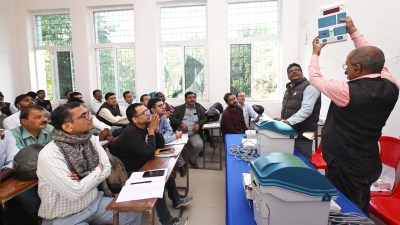Crouching Tiger,Hidden Dragon
Pranab Bardhan challenges much of the celebratory literature on the economic rise of China and India....
Assessing the economic rise of China and India,also the subtitle of Pranab Bardhans new book,is without doubt the fashionable subject of our times,especially in the post-financial crisis period. There is plenty of conventional wisdom that celebrates these two emerging economies as the stars of the future. Bardhans book,on the other hand,challenges much of the celebratory literature on the two countries.
The book isnt likely to please free-market enthusiasts. One of the wisdoms the Berkeley economist argues against early on is what he believes is disproportionate credit given to liberalisation and globalisation in explaining the success of these economies between 1980 and 2005. In Indias case,Bardhan argues,since economic reform has largely focused on liberalising trade and industrial policies,it is the corporate sector that has benefited by becoming more efficient. However,the formal corporate sector employs only about 5 per cent of the workforce and so the broader benefits of economic reform are questionable according to the author. Provocatively,Bardhan also argues that the rate of poverty decline in India in the post-reform period of 1993-2005 hasnt be any higher than the rate of decline in the 1970s and 1980s. Of course,it is possible to counter both these propositions poverty statistics are dodgy at best and Bardhan may be underestimating the spillover effects of economic liberalisation. But the author does manage to highlight the enormity of the task that lies ahead of India.
Even in China,Bardhan stresses on the importance of the initial conditions,created by the state,when integration with the global economy began. Chinas enviable effort at land reform and heavy investments in eduction,health and other social sectors in the socialist period (in sharp contrast to Indias socialist period) meant that the fruits of growth were always going to percolate more deeply than in India.
That said,the book is no plea for a return to statist economics and will therefore displease ideologues on the left as much as on the right. Bardhan is scathing on the inefficient,corrupt and rent-seeking nature of the Indian state that has more often than not focused on short-term populism rather than long-term vision. The chapter on social sectors is a stark reminder of the states failure in the provision of these basic services in India. And the chapter on agriculture does a brilliant job of comparing Chinas relative success in raising agricultural productivity and output through the right kind of state intervention (land reform,public investment in infrastructure,contract farming) with Indias dismal failure through the wrong kind of intervention (direct price and quantity interventions). Given that agriculture still employs a significant proportion of the workforce (usually the poorest) in both countries,what happens in this sector still matters most for poverty and inequality.
But perhaps the most fascinating parts of the book are the ones where Bardhan moves from economics to his forte of political economy. His is perhaps the most nuanced analysis of the democracy vs authoritarianism debate that is an integral part of any discussion on India and China. Eschewing simplicity,Bardhan deconstructs Chinas authoritarianism and Indias democracy and highlights the strengths and weaknesses of each. Contrary to popular perception,the Chinese state has delivered better than India not because it is centralised but because it is fiscally,financially and managerially decentralised. Regional and local governments and public-sector enterprises have a fair degree of autonomy from Beijing,which has led to better outcomes. Still,if conflicts were to arise,Chinas closed political system will find it harder to respond than Indias plural democracy. However,Indian democracys weakness is that it hasnt been effective in enforcing accountability from the state. A once-in-five-years election,he says,for example,is too blunt an instrument to enforce accountability in the delivery of public services. How exactly the political economies of the two states evolve is as likely to determine the future of India and China as are their respective integrations with the global economy.
Even though this is an academic book replete with footnotes,references and,occasionally,economics jargon,it is very readable (and only 168 pages long) and deserves a much wider audience. It is about as ideology-neutral and objective an account of the India and China stories as one is likely to get.



- 01
- 02
- 03
- 04
- 05



























